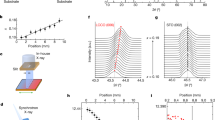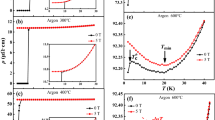Abstract
Mang et al. observe a cubic (Nd,Ce)2O3 impurity phase grown epitaxially in annealed samples of electron-doped Nd2−xCexCuO4 (NCCO). They claim that this impurity phase has long-range order parallel to the CuO2 planes of NCCO but extending only about 4ac perpendicular to the planes, thus forming a quasi-two-dimensional (Nd,Ce)2O3 lattice matched with the a–b plane of NCCO.
Similar content being viewed by others
Kang et al. reply
Although we have confirmed the presence of such an impurity phase, (Nd,Ce)2O3 in our samples forms a three-dimensional long-range structural order1 and is unrelated to the quasi-two-dimensional superlattice reflections1,2. In the paramagnetic state of (Nd,Ce)2O3, a field will induce a net moment on magnetic Nd. By arbitrarily scaling the impurity scattering at (0,0,2.2) for fields less than 7 T to our c-axis field-induced scattering of NCCO at (1/2,1/2,0), Mang et al. argue that our observed magnetic scattering2 is due entirely to (Nd,Ce)2O3. We disagree, however.
There are three ways to resolve this impurity problem. First, if the magnetic scattering at (1/2,1/2,0) (ref. 2) is due entirely to (Nd,Ce)2O3, one would expect the field-induced intensity to be identical when B is parallel to the c-axis and when it is parallel to the [1, −1,0] axis, as required by the cubic symmetry of (Nd,Ce)2O3. Experimentally, we find that the field-induced effect at (1/2,1/2,0) is much larger when B is parallel to the c-axis1, which is inconsistent with the cubic symmetry of (Nd,Ce)2O3 but consistent with the upper critical field of NCCO being much smaller in this geometry1,2.
Second, as the lattice parameter of (Nd,Ce)2O3 does not match the c-axis lattice parameter of NCCO (ref. 1), measurements at non-zero integer L cannot be contaminated by (Nd,Ce)2O3. Our experiments indicate that the (1/2,1/2,3) peak shows an induced antiferromagnetic component when the field is along the c-axis and hence superconductivity is strongly suppressed1, but not when in the a–b plane and superconductivity is only weakly affected2. This is direct proof of the connection between field-induced antiferromagnetic order and suppression of superconductivity in NCCO. We also note that the qualitatively different behaviour observed when B is perpendicular to c, in comparison with when it is parallel to c, directly violates the cubic symmetry of (Nd,Ce)2O3.
Finally, an independent report3 confirms our principal findings1,2 in studies of annealed superconducting Pr0.89LaCe0.11CuO4 (PLCCO), a similar electron-doped material in which the cubic impurity phase (Pr,La,Ce)2O3 has a non-magnetic ground state and no field dependence below 7 T (our unpublished observations). For fields up to 5 T, Fujita et al.3 find enhanced antiferromagnetic order at (1/2,3/2,0) with increasing field in PLCCO. Above 5 T, this order decreases with increasing field, which is consistent with the field dependence of (1/2,1/2,0) of NCCO (ref. 2). The agreement between two different electron-doped systems in two independent experiments1,2,3 confirms the quantum phase transition from the superconducting to an antiferromagnetic state in electron-doped, high-Tc superconductors2.
References
Matsuura, M. et al. Phys. Rev. B 68, 144503 (2003).
Kang, H. J. et al. Nature 423, 522–525 (2003).
Fujita, M., Matsuda, M., Katano, S. & Yamada, K. Physica B (in the press).
Author information
Authors and Affiliations
Corresponding author
Rights and permissions
About this article
Cite this article
Kang, H., Dai, P., Lynn, J. et al. Spurious magnetism in high-Tc superconductor. Nature 426, 140 (2003). https://doi.org/10.1038/426140a
Issue Date:
DOI: https://doi.org/10.1038/426140a
Comments
By submitting a comment you agree to abide by our Terms and Community Guidelines. If you find something abusive or that does not comply with our terms or guidelines please flag it as inappropriate.



